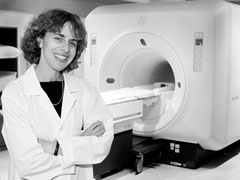Staying Abreast
By Laura Pratt
Ellen Warner is waiting.
Of course she has no choice. In her line of work, the waiting is one-half of the battle. It was a decade ago that this associate scientist at Sunnybrook Research Institute and medical oncologist at Sunnybrook Health Sciences Centre, together with her team, launched a study to determine whether magnetic resonance imaging (MRI) was a more accurate screening tool than mammography for detecting early breast cancer in high-risk women. In 2004, Warner surfaced to announce that, yes, MRI was more sensitive and specific in detecting small breast cancers than mammography, ultrasound or clinical breast exam (CBE) in this group. The study had screened 236 Canadian women who had BRCA1 or BRCA2 mutations with MRI, mammography, ultrasound and CBE on the same day. Of the 22 cancers detected, MRI found 17 (77%); mammography, eight (36%); ultrasound, seven (33%); and CBE, two (9.1%).
But before MRI could be used as a more general screening tool, Warner cautioned, researchers needed to prove that it’s also better at saving lives.
Fast forward to 2007.
All told, some 350 high-risk women in Warner’s new study — the next stage in the MRI research — will be matched according to their age and mutation to high-risk women who have not been screened with MRI. “Our hopes are that we’re going to see differences,” says Warner. “In comparing those women who have developed breast cancer over the study period, we expect a much earlier cancer stage, and a lower relapse and death rate [in the MRI-screened women].”
Warner and her colleagues will start looking at data in autumn 2007 and expect to present results about six months later.
Also in the fall, Warner’s revised program aimed at educating women about their likelihood of developing breast cancer will be launched. Hereditary Breast Cancer continues an old research project, unveiled in 2001, that advises women whose family members have had breast cancer about their own risk for the disease. This new version—produced by a clutch of doctors (at Mount Sinai, Women’s College and Sunnybrook), including Warner—will be distributed under the auspices of the Canadian Cancer Society (CCS).
This second version of the booklet is distinguished from the first for one notable addition—data on the availability of MRI for screening high-risk women—and one notable exclusion—CBE, following the release of evidence that CBE does not save lives. It will also advise that tamoxifen and raloxifene have each been shown to lower the risk of breast cancer by about 50% in high-risk women.
The CCS will send copies to every family physician in Ontario to give to their patients who have a family history of breast cancer during breast cancer awareness month (October). In addition, the doctors will receive a triage card to help them categorize patients and plan for their risk management with appropriate screening and prevention.
Finally, Warner is engaged in a randomized controlled trial, Can We Fix What We’ve Broken? Launched six months ago, it targets breast cancer survivors who have completed their treatment but are struggling with body image. “These are women who have lost a breast, have funny-looking breasts, have gained 30 lbs, who just don’t feel attractive,” says Warner. An eight-week session with a trained therapist encourages them to learn the value of positive body imaging.
Can We Fix What We’ve Broken?, for which Warner anticipates preliminary results in the fall, is just one initiative in a larger planned program that addresses the particular considerations of women diagnosed with breast cancer before age 40.
“There’s more to come,” she says. “But for now, I’m waiting.”
Warner’s MRI study was funded by the Canadian Breast Cancer Research Alliance (CBCRA); her “information aid” study is currently funded by the Canadian Cancer Society; and Can We Fix What We've Broken is funded by the CBCRA.
PDF / View full media release »





